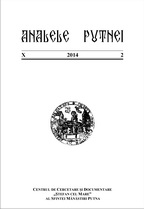Tipografia Mitropoliei Moldovei la mijlocul secolului al XVIII-lea: ipoteze, îndreptări, consideraţii
The Printing Press of the Moldavian Metropolia at the Middle of the 18th Century: Hypotheses, Rectifications, Considerations
Author(s): Mihai MîrzaSubject(s): History
Published by: Centrul de cercetare şi documentare ŞTEFAN CEL MARE
Keywords: printing press; Moldavian Metropolia; Bishop Varlaam of Rădăuţi; Metropolitan Jacob of Putna; printer Ieremia Marcu
Summary/Abstract: The appearance, short term functioning and sudden and inexplicable disappearance of the printing press of the Rădăuţi Diocese (1744–1746) gave rise to certain controversies in the Romanian historiography. More than eight decades ago N. Iorga stated the hypothesis that the Rădăuţi printing press was brought to Iaşi by Metropolitan Jacob right after he became the Metropolitan of Moldavia on November 13, 1750. Up to now, though, no one examined what had happened to the old printing press of the Metropolia and its printer, Ieremia Marcu who did not depart from Iaşi during the first half of the 18th century. The author corroborates the extant sources to make several hypotheses. The first is that the printing press operated in Iaşi until 1742 when it was taken to Rădăuţi from where it was brought back to Iaşi in 1747 by Metropolitan Nicephorus Sidis. Its activity in Iaşi restarted in 1474 with the Euchologion, which came out in 1749. The decision of taking the printing press to Rădăuţi belonged, no doubt, to Constantin Mavrocordat, the ruler of Moldavia, who probably wanted to favor the Greek printer Duca Sotiriovici who had his own printing press in Iaşi in those years. It seems that the official reason for the move was the need to print service books, antimensia and ordination certificates for priests in order to support the Orthodox faithful from Northern Transylvania who were assaulted by Catholic propaganda after the Habsburg authorities had suppressed the Maramureş Diocese in 1738. The author also shows that Metropolitan Jacob of Putna reorganized the printing press in 1754 bringing new printing tools and hiring a team of professional printers, headed by Barbu Bucureşteanul, who printed books in admirable graphic and artistic conditions. Also, the Metropolitan reinstated the monopoly of the Metropola’s printing press, most probably by withdrawing the printing right from Duca Sotiriovici, whose printing press stopped operating in 1753.
Journal: Analele Putnei
- Issue Year: 2014
- Issue No: 2
- Page Range: 49-72
- Page Count: 24
- Content File-PDF

